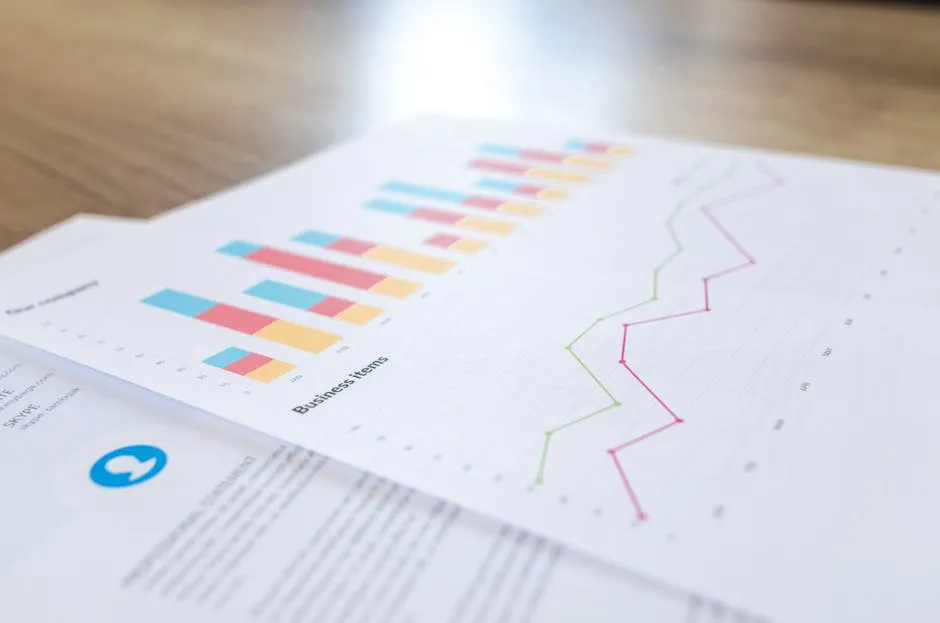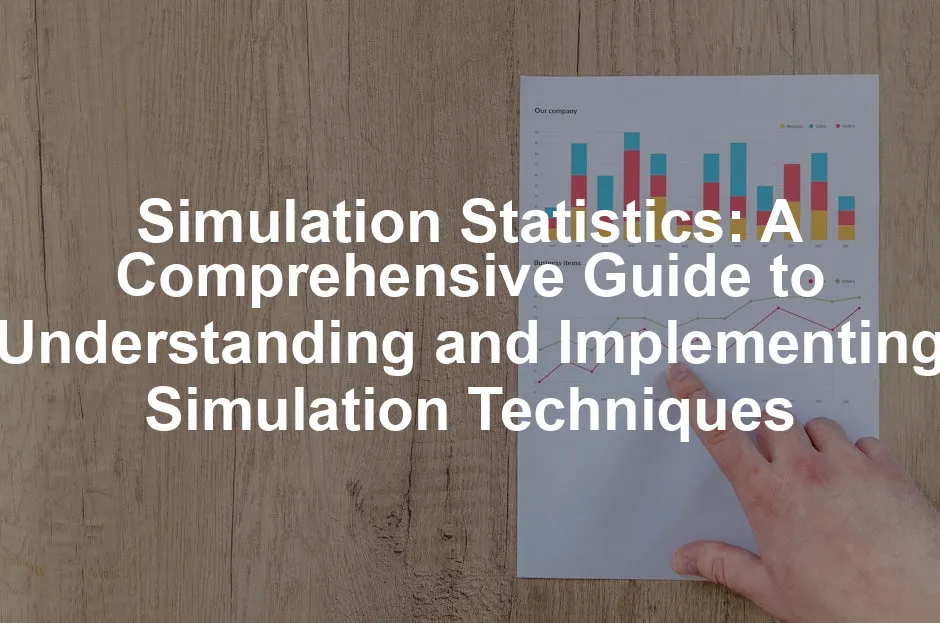Introduction
Simulation statistics is a fascinating field that models random events and helps us understand complex systems. It finds applications in various domains, including engineering, economics, and social sciences. Think of it as a magic trick, but instead of pulling rabbits out of hats, it conjures data from thin air!
Why is simulation so important? Well, some scenarios are too intricate for straightforward mathematical formulas. Others may be cumbersome or costly to analyze. In such cases, simulation comes to the rescue! It provides a way to approximate real-world results without the headache of traditional analytical methods. By estimating probabilities and testing hypotheses through simulated environments, researchers can better grasp the unpredictable nature of the world around us.
This article serves as your ultimate guide to simulation statistics. We’ll explore various methods and applications, from Monte Carlo simulations to bootstrapping techniques. Along the way, we’ll share best practices to help you run effective simulations. Expect to walk away with a robust understanding of how to implement simulation techniques in your own work. So, buckle up and get ready for a wild ride through the world of simulation statistics!

Understanding Simulation Statistics
What is Simulation Statistics?
Simulation statistics involves using computer algorithms to generate data based on defined probabilistic models. At its core, it models random events to estimate statistical properties. It’s like a laboratory for statisticians, where they can test hypotheses without the constraints of reality. This powerful tool is essential for analyzing complex systems where traditional approaches may fall short.
Key concepts in simulation statistics include random variables, distributions, and Monte Carlo simulations. Random variables are essential building blocks; they represent outcomes of random phenomena. Distributions describe how these variables behave, whether they follow a normal curve or take on other shapes. Monte Carlo simulations, on the other hand, utilize random sampling to derive numerical results. By running thousands of simulations, researchers can approximate the behavior of systems under various conditions.
Imagine tossing a coin. Each flip represents a random variable. Over time, you can build a distribution of outcomes—heads or tails. Now, if you wanted to understand the probability of getting a certain number of heads in a series of flips, simulation statistics would help you achieve that! By simulating thousands of coin tosses, you could estimate probabilities more accurately than by relying on a simple formula.
As we venture deeper into the world of simulation statistics, you’ll uncover how these techniques can transform your analyses and lead to more informed decision-making. So, let’s keep the momentum going and explore the different types of simulations next!

Types of Simulations
Monte Carlo Simulation
Monte Carlo simulations are like the party tricks of statistics. They use randomness to solve problems that are often too complex for straightforward calculations. This method is particularly useful in statistical modeling and estimation. Picture a casino: you roll the dice thousands of times to gauge the odds of winning. Similarly, Monte Carlo simulations run numerous trials to estimate the likelihood of various outcomes. They help in fields ranging from finance to engineering by providing insights into risk and uncertainty.
To dive deeper into the world of data and statistics, check out The Art of Statistics: Learning from Data by David Spiegelhalter. This book provides a comprehensive understanding of how to analyze data effectively.

Bootstrapping
Bootstrapping is the magician’s wand of estimating distributions. This technique allows statisticians to estimate the distribution of a statistic by resampling with replacement from the original data. Imagine you have a small sample, and you want to understand the variability of the mean. By repeatedly sampling from your original dataset, you can create a pseudo-population. This method is especially handy for constructing confidence intervals and assessing statistical significance without making strong parametric assumptions.
For those looking to enhance their data science skills, R for Data Science is a fantastic resource to learn how to manipulate and visualize data effectively.

Permutation Tests
Permutation tests are like a game of musical chairs for data. They assess the significance of an observed effect by calculating all possible values of a test statistic under the null hypothesis. In simpler terms, you shuffle your data around to see how often you get results as extreme as your observed effect. This non-parametric method is particularly valuable when the sampling distribution of the test statistic is unknown. It provides a robust framework for hypothesis testing without relying on normality assumptions.

Applications in Bayesian Statistics
In the realm of Bayesian statistics, simulations are akin to a crystal ball, providing a glimpse into posterior distributions. Simulations, especially Markov Chain Monte Carlo (MCMC), enable statisticians to estimate complex models where direct calculations of the posterior distribution are tough. By simulating draws from the posterior, researchers can make inferences about parameters, assess model fit, and conduct hypothesis tests. This approach has revolutionized Bayesian analysis, making it more accessible and practical. For a fun way to delve into Bayesian statistics, check out this comprehensive guide.
Understanding Bayesian statistics can enhance your insights into complex models. Explore Bayesian statistics the fun way.

Benefits of Simulation in Statistics
Why Use Simulation?
Flexibility
Simulations are like Swiss Army knives for statisticians, offering versatility in tackling complex problems. When analytical solutions are elusive, simulations come to the rescue. They can model intricate systems, from financial markets to biological processes, without being hampered by the constraints of traditional methods. Whether you’re simulating the spread of a disease or forecasting stock prices, simulations adapt to your needs, providing a tailored approach to analysis.

Cost-Effectiveness
Why break the bank on extensive data collection or complicated experiments? Simulation can save time and resources while still delivering valuable insights. By modeling scenarios and running simulations, researchers can explore numerous possibilities without the need for exhaustive fieldwork. Imagine testing different marketing strategies through simulations rather than conducting costly real-world experiments. This cost-effective approach allows for rapid insights while minimizing expenses.

Robustness Testing
Robustness testing is like putting your statistical models through their paces. Simulation helps assess how well these models perform under various assumptions. For instance, you can evaluate how sensitive your results are to changes in parameters or distributions. This process ensures that your conclusions remain valid, even when the underlying conditions change. By simulating different scenarios, you gain confidence in your model’s reliability and robustness.

Real-World Applications
Case Studies
Simulation statistics have made waves across various fields, proving their worth through practical applications.
In healthcare, consider the case of a medical facility using simulation to optimize patient flow. By modeling patient arrivals, treatment processes, and discharge times, hospitals can reduce wait times and enhance service quality. This method helped a prominent hospital cut patient wait times by 30%, ensuring that no one had to twiddle their thumbs in discomfort.

In finance, simulations play a vital role in risk assessment. For instance, a leading investment firm utilized Monte Carlo simulations to predict the future performance of their portfolio. By simulating thousands of market scenarios, they gained insights into potential risks and returns. The result? More informed investment decisions led to a 15% increase in portfolio performance over a year.
Engineering isn’t left out either. Imagine a bridge design team using simulation to test how various loads affect structural integrity. By simulating different environmental conditions and load scenarios, engineers can predict failure points and optimize designs before breaking a single beam. One engineering firm reported a significant reduction in costs and time by implementing simulations in their design process.
For those interested in diving deeper into data modeling, Introduction to Probability and Statistics by William Mendenhall is a great read to build foundational knowledge.

Discussion of Outcomes
The insights gained from these simulations have far-reaching implications. In healthcare, reducing wait times not only improves patient satisfaction but also enhances overall outcomes. Patients receive timely care, leading to better recovery rates and fewer complications.
For finance, understanding risk through simulation allows firms to allocate resources more efficiently. By knowing which investments carry higher risks, companies can adjust their strategies and ensure better financial health.
In engineering, the ability to simulate various conditions means designs can be tested before physical implementation. This proactive approach minimizes costly redesigns and construction delays, ultimately resulting in safer and more efficient structures.
In essence, simulation statistics empower decision-makers by providing a crystal-clear view of potential outcomes. By applying these techniques, industries can navigate uncertainties with confidence, transforming complex problems into manageable solutions.

Execution of Simulation
Step-by-Step Process
Executing a simulation requires a clear roadmap. Here’s how to navigate this journey:
- Define Outcomes: Start by outlining all possible outcomes. What are you hoping to achieve?
- Link Outcomes to Random Numbers: Assign random numbers to these outcomes. For instance, if tossing a coin, heads might be 1 and tails 0.
- Select a Random Number Source: Choose how you’ll generate random numbers. You could use a random number generator, flip a coin, or roll a die.
- Generate Random Numbers: Now, it’s time to draw your random numbers.
- Record Simulated Outcomes: Based on the random numbers, note down the outcomes. Keep track of what happens.
- Iterate: Repeat the previous steps many times. The more iterations, the better your insights.
- Analyze Results: Finally, analyze the collected outcomes to derive meaningful results.
Reproducibility is crucial. Always document your methods and random number seeds to ensure others can replicate your simulation.

Example Scenario
Let’s simulate a simple regression model. Imagine we want to analyze the relationship between hours studied and test scores.
Here’s a straightforward R code snippet to illustrate:
# Set parameters
n <- 100 # number of students
set.seed(42) # for reproducibility
# Generate data
hours_studied <- rnorm(n, mean=5, sd=2) # hours studied
error <- rnorm(n, mean=0, sd=1) # random error
test_scores <- 50 + 10 * hours_studied + error # test scores
# Fit a linear model
model <- lm(test_scores ~ hours_studied)
# Summary of the model
summary(model)
This simple code helps you understand how hours of study might affect test scores. It generates random data, fits a linear model, and summarizes the results.

Analyzing Results
Statistical Measures
Analyzing simulation results involves calculating key statistical measures. Start with:
- Mean: The average of your results. It gives a central tendency.
- Variance: This measures the dispersion of outcomes around the mean. A higher variance indicates more spread.
- Confidence Intervals: These intervals provide a range in which we expect the true mean to fall, offering insights into uncertainty.
For example, if our test scores had a mean of 75 and a variance of 20, we can interpret that the average score is 75, but students’ scores are spread out rather widely.

Visualizations
Visualizing simulation results helps convey complex data simply. Graphs and charts make patterns stand out. Use:
- Histograms: Great for showing distributions of outcomes.
- Boxplots: Useful for visualizing summary statistics and spotting outliers.
- Scatter Plots: Excellent for depicting relationships between variables.
Visual representations can make or break your analysis. They not only clarify your findings but also engage your audience. After all, who doesn’t love a pretty chart?
Best Practices
Rigorous Testing
Testing your assumptions is crucial when conducting simulations. Think of it as checking your parachute before jumping. You wouldn’t want to find out mid-air that it has a hole, right? Make sure to run various scenarios and stress-test your models. This ensures that your results are robust and reliable. Comprehensive testing helps identify potential flaws early on, ultimately leading to more accurate outcomes.
Documentation
Documentation is your best friend in simulation studies. It’s like leaving breadcrumbs for others (and yourself) to follow. Clearly outline your methods, parameters, and results. This practice enhances reproducibility, allowing others to validate your findings. Detailed documentation not only benefits others but also helps you remember what you did if you revisit your work later. Who doesn’t appreciate a good roadmap in the world of statistics?
Iterative Refinement
Simulations should be viewed as a work in progress. Don’t hesitate to refine your models based on initial findings. The first attempt is rarely perfect, much like that first pancake that always ends up a bit wonky. Analyze your results, gather feedback, and make adjustments. Iterative refinement allows you to improve the accuracy and effectiveness of your simulations, leading to better insights and outcomes.
Conclusion
Simulation statistics play a pivotal role in modern research and analysis. By providing a framework to model random events, they help us gain insights into complex systems. Throughout this guide, we’ve explored various techniques, including Monte Carlo simulations, bootstrapping, and permutation tests. Each method offers unique advantages, making them invaluable across numerous fields like healthcare, finance, and engineering.
Key points to remember include the flexibility of simulations. They allow researchers to tackle problems that traditional methods struggle with. Additionally, simulations save time and resources, making them a cost-effective option. The ability to conduct robustness testing further emphasizes their importance. By testing models under different conditions, one can ensure the reliability of results.
Looking ahead, emerging trends in simulation statistics promise exciting developments. With advancements in computational power and software capabilities, simulations will become even more sophisticated. Techniques like machine learning integration can enhance the accuracy of simulations, making them more applicable to real-world scenarios. As researchers continue to explore these avenues, the impact of simulation statistics on research and practice will only grow.
Now, it’s your turn! Don’t just sit back and admire the beauty of simulation statistics. Apply these techniques in your own analyses. Whether you’re estimating probabilities, testing hypotheses, or modeling random events, simulations can provide clarity and depth to your work. Embrace the power of simulation and watch your statistical analyses soar!
FAQs
What is the difference between simulation and traditional statistical methods?
Simulation techniques offer more flexibility than traditional methods. While classical statistics often rely on specific assumptions, simulations can model complex problems without strict constraints. This adaptability allows for better insights into real-world scenarios, making simulations essential when dealing with intricate data.
How do I choose the right simulation method for my study?
Selecting the right simulation method depends on several factors. Consider the nature of your data, the complexity of the problem, and your research objectives. For instance, if your data is non-normally distributed, bootstrapping might be more suitable. Understanding these considerations can help you make an informed choice.
What are some common applications of simulation statistics?
Simulation statistics find applications in various fields. In healthcare, they optimize patient flow and reduce wait times. In finance, they assess risks and inform investment strategies. Environmental scientists use simulations to model climate change, while engineers rely on them to test structural designs. The versatility of simulation techniques makes them invaluable across disciplines.
Are there any free tools for conducting simulations?
Absolutely! Several free tools are available for conducting simulations. R and Python are popular choices, offering robust libraries for statistical modeling. Additionally, software like Jupyter Notebook makes it easy to document and share simulation projects. These resources empower researchers to explore simulation techniques without breaking the bank.
Please let us know what you think about our content by leaving a comment down below!
Thank you for reading till here 🙂
All images from Pexels




